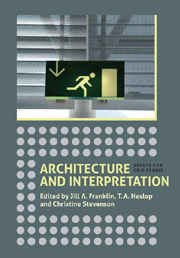Book contents
- Frontmatter
- Contents
- List of Illustrations
- Preface: In Appreciation
- List of contributors
- 1 Introduction
- Incitements to Interpret in Late Antique and Medieval Architecture
- 16 Believing is Seeing: The Natural Image in Late Antiquity
- 42 Articulation as an Expression of Function in Romanesque Architecture
- 60 Barrel-Vaulted Churches in Late Medieval Scotland
- 78 Augustinian and Other Canons' Churches in Romanesque Europe: The Significance of the Aisleless Cruciform Plan
- 99 Towers and Radiating Chapels in Romanesque Architectural Iconography
- 111 Diffusion, Imitation and Evolution: The Uncertain Origins of ‘Beakhead’ Ornament
- 128 Architecture and Pattern: The Western Façade of Lincoln Cathedral and Modernist Reference Points for its Interpretation
- Authors and Intentions
- Architecture beyond Building
- Index
60 - Barrel-Vaulted Churches in Late Medieval Scotland
from Incitements to Interpret in Late Antique and Medieval Architecture
Published online by Cambridge University Press: 05 April 2013
- Frontmatter
- Contents
- List of Illustrations
- Preface: In Appreciation
- List of contributors
- 1 Introduction
- Incitements to Interpret in Late Antique and Medieval Architecture
- 16 Believing is Seeing: The Natural Image in Late Antiquity
- 42 Articulation as an Expression of Function in Romanesque Architecture
- 60 Barrel-Vaulted Churches in Late Medieval Scotland
- 78 Augustinian and Other Canons' Churches in Romanesque Europe: The Significance of the Aisleless Cruciform Plan
- 99 Towers and Radiating Chapels in Romanesque Architectural Iconography
- 111 Diffusion, Imitation and Evolution: The Uncertain Origins of ‘Beakhead’ Ornament
- 128 Architecture and Pattern: The Western Façade of Lincoln Cathedral and Modernist Reference Points for its Interpretation
- Authors and Intentions
- Architecture beyond Building
- Index
Summary
SCOTTISH medieval church architecture took on its most distinctive form between the late fourteenth century and the Reformation of the Church that was formalized in the parliament of 1560. Before then, over the course of the twelfth and thirteenth centuries, the closest ongoing architectural relationships in the Lowland areas had been with England, although it is true that by the later thirteenth century masons were demonstrating an increasing willingness to develop solutions in which models from south of the Border might be little more than a starting point. It may also have been the case by then that Lowland Scotland was itself as much a testing ground for new ideas as was northern England. However, by the later fourteenth century, following some seventy-five years of intermittent warfare between Scotland and its southern neighbour that had erupted in 1296, and which left relatively little opportunity for major church building, there appears to have been a growing sense among Scottish patrons and masons that it was no longer acceptable to have such close architectural links with England.
The range of sources of inspiration underlying the late-medieval Scottish architectural synthesis is still only partly understood. Nevertheless, against the background of a greatly diminishing number of debts to England, it appears that strengthened political, diplomatic, commercial and cultural links with France and the Low Countries resulted in significant direct borrowings from those areas, and perhaps from other parts of the Continent as well.
- Type
- Chapter
- Information
- Architecture and InterpretationEssays for Eric Fernie, pp. 60 - 77Publisher: Boydell & BrewerPrint publication year: 2012



